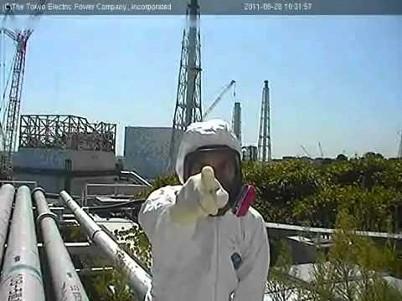
‘Don’t Follow the Wind’ is a refrain we need to remember in today’s radioactive environment. It is also the poignant title of the inaccessible exhibition Jonathon Jones so crudely criticizes ('Apocalyspe No! Why artists should not go into the Fukushima exclusion zone' Guardian 10.07.2015). Jones is so busy pontificating on his nuclear beliefs he doesn’t tell us anything about the art project.
‘Don’t Follow the Wind’ is an exhibition inside the restricted radioactive zone surrounding the Fukushima Nuclear Power Plant. The project was initiated by the Japanese art collective Chim↑Pom and developed with curators Kubota Kenji, Eva & Franco Mattes, and Jason Waite; presenting new work by twelve artists from Japan and around the world, situating the concerns of the nuclear accident within an international context.
The audio introduction on the image-less website http://dontfollowthewind.info/ reflects on how the project addresses concepts of invisibility and deep time. The exhibition presents new artworks in sites lent by the community that was evacuated after the disaster. It will only be able to be viewed when the area is decontaminated and people will be able to return, until then it remains invisible. As Trevor Paglan says “What cannot be perceived has an immense power.” It seems this lack of ability to perceive has given Jones the license to make things up!
It’s a shame that Jones can’t contribute to the ‘rational’ debate he craves, and do some more research into the artistic practices he accuses of “feasting on the apocalyptic image of nuclear disaster.” It is perhaps due to the subtle complexity of the artwork refusing to provide images of an exhibition that audiences cannot see, that Jones has created his own projections of ‘apocalypse’, and ‘nuclear catastrophe’.
The reality of living in a radiation exclusion zone is not “sci-fi” but everyday life for thousands of people in Japan. In Fukushima City the surfaces of the outdoor spaces are being scrubbed, topsoil in parks and gardens removed, and workers commute into the non-residential zones daily.
Jones seems confused as to why the Power Plant and not the tsunami or earthquake remains an iconic subject for artists. Although the earthquake and tsunami were a ‘natural’ disaster, the meltdown of the Fukushima Dai’ichi Nuclear Power Plant was a manmade catastrophe, the ‘earth’ was not at ‘fault’. Along the coast, the havoc wrecked by the quake and tsunami has been largely repaired and rebuilt, whilst the decontamination process has no fixed timeline, and latest estimates go beyond the initial 40 years, and could take more than 100 years. Periods that expand beyond our lifetime, and make us reconsider our relation to art, the environment and time itself.
The ‘Don’t Follow the Wind’ project ensures political visibility of the complex psychic and radiological impacts of the disaster, not through apocalyptic images, but simply by revealing the world as it really is.
Yours,
Ele Carpenter
Associate Curator, Nuclear Culture, Arts Catalyst
http://nuclear.artscatalyst.org
A shorter version of this letter was sent to the Guardian Letters Page, 26 July, 2015.
Jones' article can be found here: http://www.theguardian.com/artanddesign/jonathanjonesblog/2015/jul/20/fu...